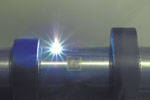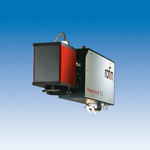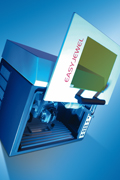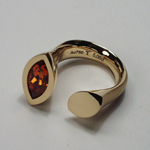17 November 2009
Rofin Lasers - Marking Metals From Performance to Precious
 The use of lasers for marking has today become commonplace in many industries and applications. Indeed many of the every - day products which we take for granted, including the keyboard used to type these words, are marked using a laser. There are however other less well known applications where lasers are used to mark individual items with data matrix codes, bar codes, serial numbers, dates and other pieces of important information, for a variety of reasons.
The use of lasers for marking has today become commonplace in many industries and applications. Indeed many of the every - day products which we take for granted, including the keyboard used to type these words, are marked using a laser. There are however other less well known applications where lasers are used to mark individual items with data matrix codes, bar codes, serial numbers, dates and other pieces of important information, for a variety of reasons.
The flexibility of the laser, combined with its capability to mark a diverse range of metals, has seen the technology become the process of choice for manufacturers of high performance components, such as those used in aerospace or Formula One race cars at one end of the spectrum and jewellers, who use lasers to mark and engrave precious metals such as gold, silver, platinum and titanium at the other.
Formula One race cars have on average some 3,500 individual components which are subject to a process of continuous improvement. Add to this the fact that any one team will have 3 cars (two race cars and a spare) and you have around 10,000 individual components which need to be managed at any given time. As part of an ongoing effort to continuously improve reliability and safety, part marking and traceability is now becoming a must for even the smallest individual components, with Formula One and other motor sport teams taking component identification very seriously.
Laser marking has now become the preferred solution for this industry as the laser is able to produce good permanent ‘readable’ codes on virtually all materials without compromising the structural integrity of the component. The laser is flexible and able to produce either round or square matrix elements although for dense information, squares are often preferred. In addition, the laser is able to mark small codes (down to 1mm x 1mm), which is not possible using other marking techniques. Due to their small size and large data capacity, the data matrix codes make it possible to identify nearly every component on the car from wishbones and steering racks, to pistons, fuel injectors and even nuts and bolts.
 Laser marking produces a high-quality permanent mark which is able to withstand extreme conditions such as heat, abrasion and caustic fluids often found in high performance applications such as motorsport or aerospace. Rofin has installed several PowerLine E-10 end-pumped vanadate laser sources at a number of F1 facilities.
Laser marking produces a high-quality permanent mark which is able to withstand extreme conditions such as heat, abrasion and caustic fluids often found in high performance applications such as motorsport or aerospace. Rofin has installed several PowerLine E-10 end-pumped vanadate laser sources at a number of F1 facilities.
The high beam quality produces a small focused spot and this combined with short pulse lengths enables high quality matrix codes to be produced on almost all materials including steel, titanium and aluminium. The PowerLine E – 10 laser can actually produce codes much smaller than 1mm x 1mm but both the mechanic and the code reader would struggle to actually find and read the code. The ability to be able to produce such a small code means that nearly all components used in a Formula One car can now be permanently marked and subsequently identified and tracked.
Lasers cut it for toolmakers
As a specialist manufacturer of high precision threading and grooving systems, Posithread UK Limited prides its self on having one of the world’s most comprehensive ranges of threading inserts, thread mills, grooving tools and tool holders. These high quality tooling components, often designed and manufactured to unique customer specifications, must be correctly marked and identified prior to shipping to the end user. More importantly, it is essential that these parts can be identified time and time again when the y are being used within an arduous manufacturing environment. For certain industries such as Oil and Gas, many components are safety critical parts and manufacturing a part using the wrong threading insert or machining an incorrect thread form could have serious consequences if the part fails in use. It is essential therefore that the identification marks on the individual inserts and tool holders remain clearly visible.
y are being used within an arduous manufacturing environment. For certain industries such as Oil and Gas, many components are safety critical parts and manufacturing a part using the wrong threading insert or machining an incorrect thread form could have serious consequences if the part fails in use. It is essential therefore that the identification marks on the individual inserts and tool holders remain clearly visible.
Posithread rely on a Rofin EasyMark II compact laser marking system to generate the component identification marks on their range of tooling and inserts., The system operates from a single phase 240 volt power source and does not require any external cooling. Having a fully enclosed marking area, EasyMark II is designated as a laser class 1 device and therefore has the same safety requirements and classification as a CD player.
The heart of the system is a diode pumped Nd:YVO4 laser source which is capable of marking a wide range of materials, including metals and plastics. The additional rotary axis used by Posithread enables the system to mark both flat and curved components with the minimum of operation intervention. With a marking field of 120mm x 120mm and the capacity to accommodate components up to 450mm x 150mm x 200mm in size, the system easily fulfils the marking requirements of Posithread.
Lasers – The Gem in Jewellery Production
Laser marking of jewellery has become an essential part of the success of many jewellery manufacturers. Laser technology provides all of the benefits of contact-free, abrasion-resistant and permanent marking for most materials such as platinum, gold, silver or titanium. Thanks to high speed, ultimate precision and the possibility of deeper engravings, marking lasers have now replaced diamond engraving at numerous jewellery manufacturers and high street jewellers.
 This however was not the case at the beginning of the new millennium. When early users began using laser marking systems, the man - machine interface in particular proved to be a restraining factor. Parts could not always be put into position with sufficient accuracy by hand, and furthermore, the adjustment and setting of the system sometimes required extensive programming knowledge of Visual Basic. The high investment costs, initially associated with marking lasers, also impeded the uptake of the technology. However, the introduction of the new low-cost Rofin EasyJewel system, specifically designed for jewellery manufacture, brought about a rapid change in the adoption of laser marking technology within the jewellery industry.
This however was not the case at the beginning of the new millennium. When early users began using laser marking systems, the man - machine interface in particular proved to be a restraining factor. Parts could not always be put into position with sufficient accuracy by hand, and furthermore, the adjustment and setting of the system sometimes required extensive programming knowledge of Visual Basic. The high investment costs, initially associated with marking lasers, also impeded the uptake of the technology. However, the introduction of the new low-cost Rofin EasyJewel system, specifically designed for jewellery manufacture, brought about a rapid change in the adoption of laser marking technology within the jewellery industry.
The classic jewellery marking application is surely engraving the inside of rings. Here, the precision of the laser allows the generation of motifs which cannot be achieved using conventional methods. Facsimiles of handwriting in calligraphic quality with different line widths can be reproduced true to the original. Another outstanding characteristic of the laser is efficiency. A standard engraving with a depth of two to three tenths of a millimetre can be completed easily within only a few minutes - including set-up times. These are the distinguishing features which establish the laser as the process with the highest performance when compared to other marking technologies.
It is not only the performance and excellent beam quality, required for efficient and high-quality processing of precious metals, but also the sophisticated all in one solution offered by Rofin’s EasyJewel which has made this system the first choice of many jewellery manufacturers and high  street jewellers. A single fixture is used to grip parts either internally or externally, thus providing the capability to produce marks not only on the inside and outside of the part, but also on the faces or edges of the part. Having entered the basic geometry and material parameters, the user can then determine the optimum marking position using the precise jogging feature, and then see a live preview from the on line camera, leaving no doubt about the position or quality of the finished product.
street jewellers. A single fixture is used to grip parts either internally or externally, thus providing the capability to produce marks not only on the inside and outside of the part, but also on the faces or edges of the part. Having entered the basic geometry and material parameters, the user can then determine the optimum marking position using the precise jogging feature, and then see a live preview from the on line camera, leaving no doubt about the position or quality of the finished product.
Rofin’s EasyJewel sophisticated marking software automatically makes geometric corrections for applications which require a non-perpendicular approach to the marking area. Large marks can easily be achieved with the help of the Auto-tilting function within EasyJewel.
Rofin laser systems offer the benefits of non-contact, abrasion-resistant, permanent marking on many different materials with high speed and high precision. Rofin offers a complete range of lasers for marking applications including CO2, YAG, Vanadate and Fibre Lasers.
- Contact Information
- Name: Mike Batchelor
- Email: sales@rofin-baasel.co.uk
- Website: www.rofin.co.uk/news_detail.asp?id=71

